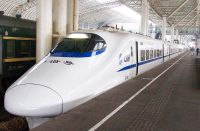
A Babu in the railway can reserve an AC seat for his dog. Similarly, he is getting a monthly emolument to appoint a Sepoy to bear his bag. Not just these prevailing practices, but also the quality of Indian Railway’s infrastructure has not changed since the British left. Indian Railway is yet to get Independence.
When the rest of the country is progressing, railway should change from the British era in every respect. On this, the proposed bullet train will be a game changer for the national carrier. A bullet train travelling at 300 km/h speed will take you from Delhi to Chennai in just six hours.
Government has planned two bullet train networks- one from Mumbai to Ahmedabad and the other from Delhi to Chennai.
The first one will be constructed with the participation of Japan while the second one with China. Money and technology will be provided by the two countries.
Both Japan and China are competing each other in foreign markets for high speed railway network construction. China has mastered the technology only in recent years especially after the noted bullet train accident at Zhejiang province three years ago.
But China’s confidence in winning train networks in foreign countries is slightly dim especially after the Mexican government has cancelled a Chinese bullet train project. Mexico has cancelled the project after public criticism about foul play at award stage. About the setback, Chinese mouthpiece, the Global Times has commented that the event shows the “harsh reality Chinese high-speed railway contractors face as they attempt to penetrate overseas markets.” The real problem is that Chinese are traditionally known for acquiring foreign projects through non-transparent ways. Chinese analysts also have a perception that India prefers Japanese participation as Japan can offer little bit of financial concession to India.
Japan on the other is marvelous as a 500 km/h bullet train has made trial run in Yamanashi Prefecture test track last month. Japan and Germany are the traditional players in the technology whereas China is a new comer.
The two bullet trains project have started with feasibility studies. Indian Railway officials comprising chairman of the High Speed Rail Corporation Satish Agnihotri has visited Biejing recently to invite the Chinese for feasibility study.
The 1,754-km Chennai-Delhi line could be the second largest in the world after China’s 2,298 km-long Beijing-Guangzhou line. The Delhi Chennai bullet train project will cost $32 billion which is near to India’s trade deficit with China for 2012-13. If China develops the network, it will turn out to be a project which makes the two colleagues than competitors.
But its investment and technological commitment is greater than the Ahmadabad Mumbai project. This requires greater political understanding between the leadership of the two countries.
On the other, for Ahmadabad Mumbai line, Japan Plus, a follow up arrangement created by the government for facilitating Japanese investment in India is speeding up the process.
As the two projects entering into the final ratification stage, India will become a model market for technological competence of the two Asian powers.
*********










